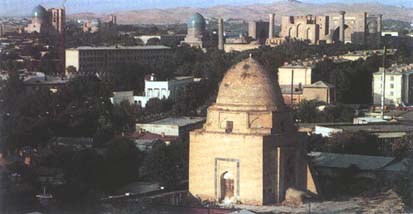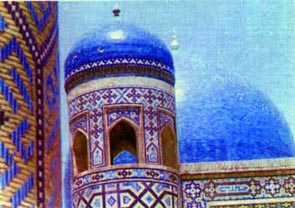... crumbing sun - baked bricks, decorated with
glazed flies of deep blue and vivid turquoise that sparkle in the sun...
a walled stairway with, on either side, a row of small mosques of the most
exquisite beauty... wainscoted with alabaster and adorned with jasper...
glimpses of courtyards and gardens... and in the open bazaars great heaps
of fruit...
Fitzroy Maclean, Eastern Approaches,
1940
It's still there, still inspiring sentences of great earnestness
and wonder from every writer who beholds it.
But besides being Central Asia's premier tourist attraction,
Samarkand is  Uzbekistan's
second city, with a population of 600,000, a major university, five other
institutes of higher education, 15 'vocational colleges', a cannery producing
200 million jars of fruit and vegetables a year and a porcelain factory
producing 22 million items of porcelain a year. All of which affects the
general feel of the place quite as much as Its ancient monuments do.
Uzbekistan's
second city, with a population of 600,000, a major university, five other
institutes of higher education, 15 'vocational colleges', a cannery producing
200 million jars of fruit and vegetables a year and a porcelain factory
producing 22 million items of porcelain a year. All of which affects the
general feel of the place quite as much as Its ancient monuments do.
If Samarkand's industrial backwardness ended with Soviet
power, so did its isolation. It is said that only two Europeans got here
in the 400 years to 1850. Nowadays Aeroflot flies in tens of thousands
of them each year and the people of Samarkand are more used to foreigners
than are any other Central Asians. Watch your wallet. This is what the
police mean when they call their city 'Bombay number two'.
Yet the Soviet impact on Samarkand was by no means all
malign. No-one had  bothered
to restore its great Timurid monuments until Lenin, in 1918, Issued a decree
that 'treasures of art and ancient culture' should be preserved, restored
and put on show for the edification of the masses. Teams of scientists
from Leningrad descended on Samarkand, rediscovered ancient glazing and
gilding techniques and substantially rebuilt the three madrasas of the
Registan. Purists called it sacrilegge. Tourists voted with their chequebooks,
and their expectations, raised by centuries of literary hype, are seldom
unfulfilled.
bothered
to restore its great Timurid monuments until Lenin, in 1918, Issued a decree
that 'treasures of art and ancient culture' should be preserved, restored
and put on show for the edification of the masses. Teams of scientists
from Leningrad descended on Samarkand, rediscovered ancient glazing and
gilding techniques and substantially rebuilt the three madrasas of the
Registan. Purists called it sacrilegge. Tourists voted with their chequebooks,
and their expectations, raised by centuries of literary hype, are seldom
unfulfilled.
'Patterns that were only tentative in Bukhara had reached
their full flourish here.' wrote Geoffrey Moorhouse in 1990. 'Colours which
had mingled blithely there achieved even more spectacular harmonies now...
For all the sumptuous inlay of its semi-precious stones, the Taj Mahal
in Agra was made to seem virginal beside the Registan in Samarkarld.'
So the Registan is beautiful. Also, very importantly,
it is big. The ruins of the Bibi Khanym mosque are big too. Indeed, they
are so big that seen from a distance in silhouette with their apparently
permanent adjuncts of tower-crane and scaffolding they are easily mis taken
for a half-built high-rise office block. Bibi Khanym and the Registan are
the grand old men of Samarkand, and sheer size is what enables them to
hold their own, defiantly and dramatically, against the big, loud, functional
city that now surrounds them.
[back]
